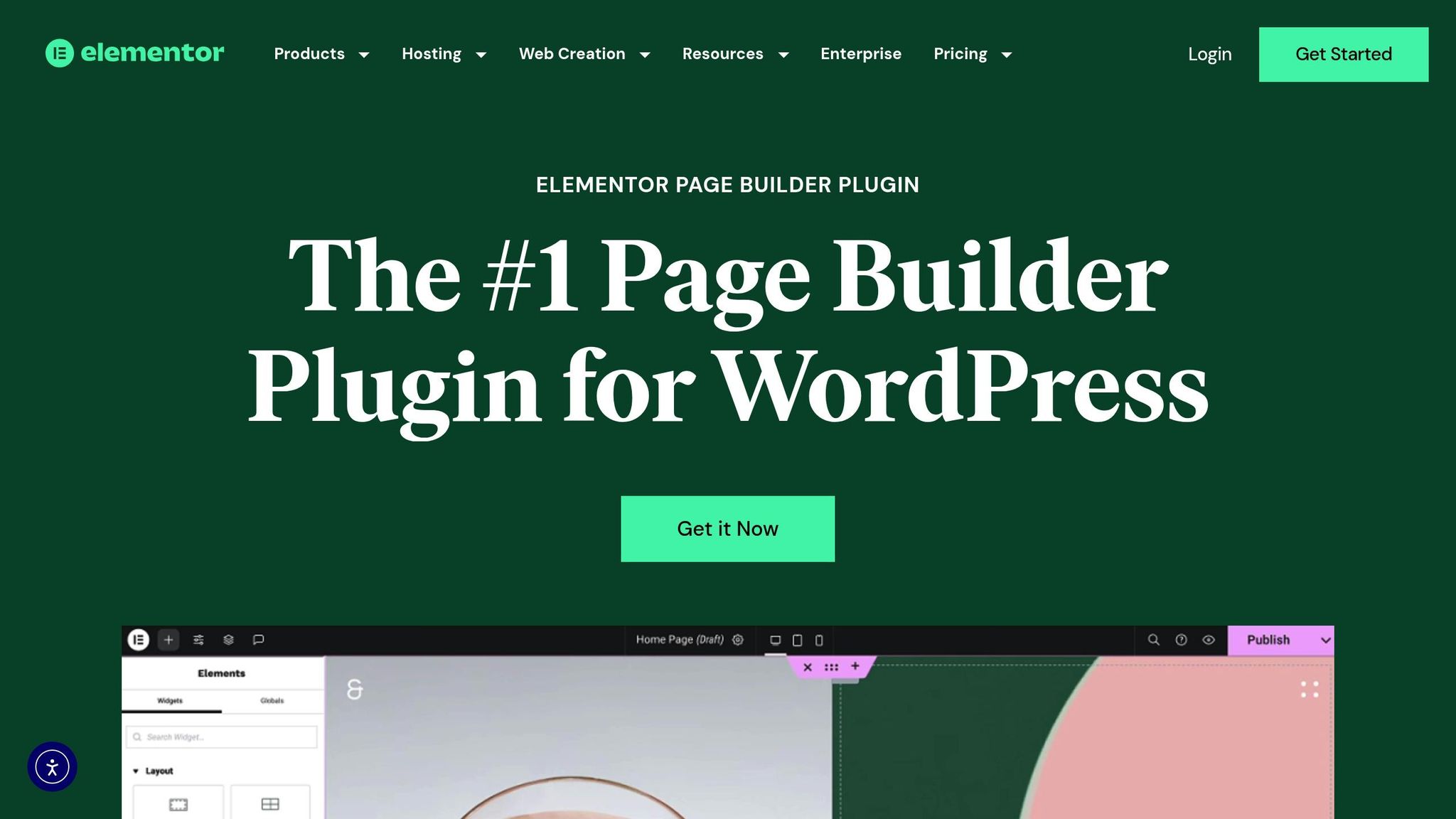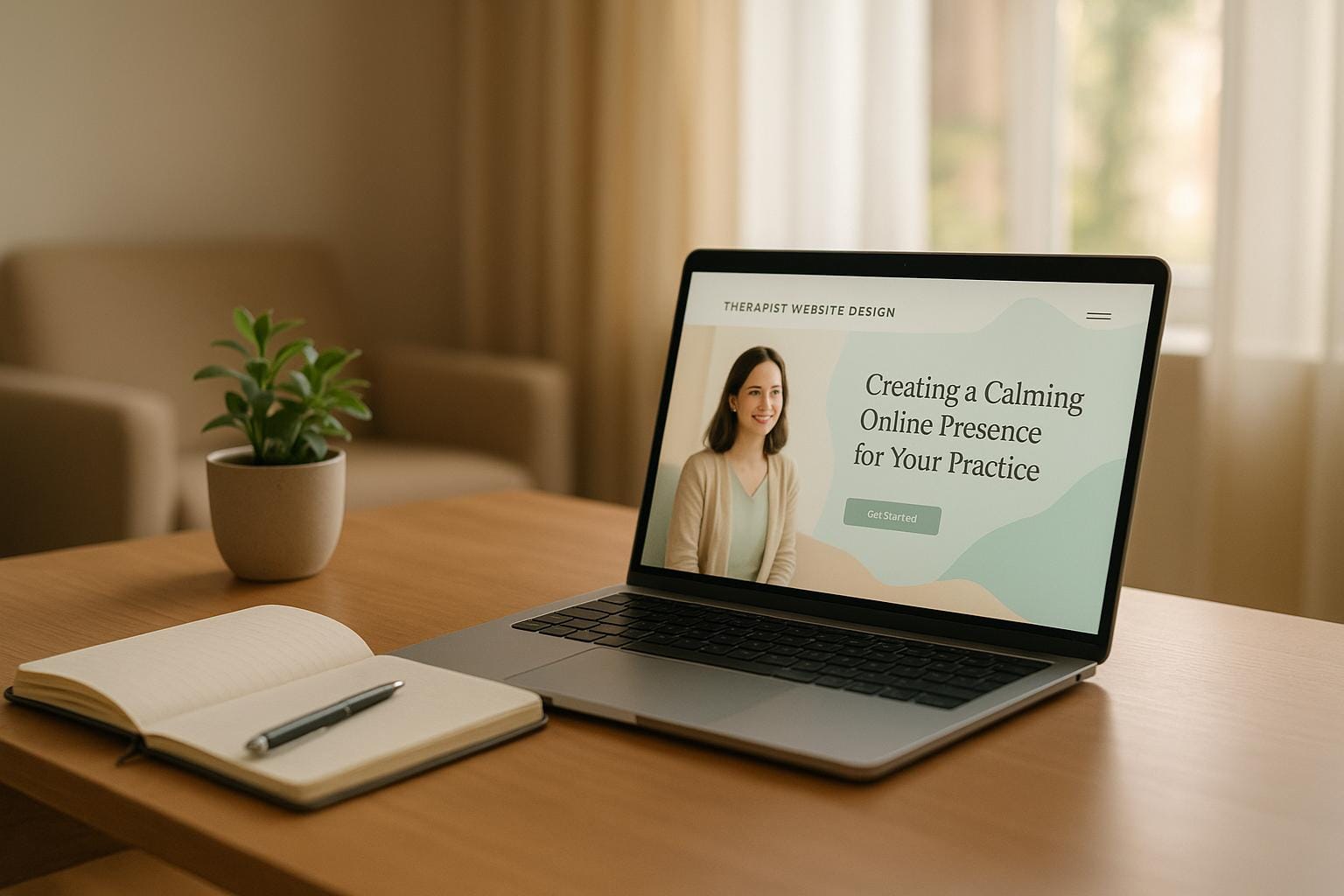Your website is often the first impression potential clients have of your practice. It should feel welcoming, professional, and calming – just like your therapy room. Here’s what you need to know:
- First Impressions Matter: Visitors form opinions in 0.05 seconds, and 75% judge credibility based on design.
- Key Design Elements: Use soothing colours (like blues and greens), clear layouts, and professional yet approachable fonts.
- Mobile Optimisation: 92% of people browse on mobile – your site must load quickly and look great on any device.
- Client-Friendly Features: Add online booking, testimonials, and self-help resources to build trust and make things easy.
- Accessibility and Security: Follow UK standards like WCAG 2.2 and GDPR to ensure your site is usable and secure for all.
Think of your website as your digital front door. It should reassure visitors, highlight your expertise, and make it simple to book an appointment. Ready to create a calming online presence? Let’s dive into the details.
Create a Therapist Website That Attracts Clients – (No Tech Skills Needed!)
Core Design Elements for Therapy Websites
Design plays a crucial role in building trust with potential clients. By focusing on elements like colours, layouts, fonts, and imagery, you can create a website that feels like a calming and welcoming space.
Selecting Calming Colours
The right colours can set the tone for your website, offering a sense of comfort and connection. Research suggests that 35% of people associate blue with relief, while 39% link green with feelings of contentment [3].
Here are a couple of colour combinations to consider:
- Teal and Purple: Soft pastel shades paired with green accents encourage mental clarity and open communication.
- Neutral with Accent Colours: Gentle greens combined with subtle orange highlights create a serene yet inviting atmosphere.
"Colors, like features, follow the changes of the emotions." – Pablo Picasso [3]
Creating Clear Website Layouts
A well-structured layout not only looks appealing but also ensures visitors can quickly access essential information. This is especially important, as 53% of users leave websites that take more than 3 seconds to load [4].
Here’s what to keep in mind for your layout:
- Navigation Structure: Make key pages like Services, About, and Contact easy to find.
- White Space: Use plenty of space between elements to minimise visual clutter and reduce stress.
- Content Hierarchy: Organise information with clear headings and subheadings for easy reading.
- Mobile Optimisation: Ensure your site looks and works flawlessly on all devices.
Choosing Fonts and Images
Typography and imagery can shape the overall feel of your website, helping it appear professional yet approachable. For example, Lauren Cañafranca of Elbie Coaching uses a mix of professional headshots and candid photos to create a relatable and genuine online presence [5].
Font Recommendations:
- Headers: Montserrat, Red Hat Display
- Body Text: Roboto, Lora
- Accent Text: Quicksand, Libre Baskerville
For images, consider using professional headshots, photos of your office, and detailed close-ups to maintain consistency and add visual depth [5].
"Even before reading the words on your website, your visitors can feel your personality, tone, and energy by the fonts that you use." – Monica Kovach, Founder and Designer at Hold Space Creative [6]
WordPress Setup Guide for Therapists
Creating a calming, client-focused online presence is just as important as fostering the right atmosphere in your practice. Setting up a WordPress website involves making thoughtful technical and design choices to reflect this ethos.
Building with Divi

Page builders like Divi allow you to design a professional, tranquil website without needing coding skills. According to Mental Health IT Solutions (April 2025), a well-designed website can play a key role in growing your practice by turning casual visitors into confirmed appointments [7].
Here’s what you’ll need to get started:
- Choose a versatile theme: Themes like Astra are compatible with drag-and-drop builders and feature pre-built layouts tailored for therapy practices [7].
- Install essential plugins:
- Security plugins
- Backup solutions
- Contact form handlers
- Appointment booking systems
WordPress offers the flexibility to easily add pages, posts, images, and videos [8]. Once your site is set up, make sure it’s optimised for mobile users.
Making Websites Work on Mobile
Did you know that 92% of internet users globally access websites on mobile devices [9]? This makes mobile optimisation an absolute must.
| Mobile Performance Metric | Target Time | Impact on Users |
|---|---|---|
| First Contentful Paint | Under 1.8 seconds | Shapes initial impression |
| Largest Contentful Paint | Under 2.5 seconds | Ensures main content loads quickly |
| Total Blocking Time | Under 200 ms | Improves interactivity |
To ensure your site performs well on mobile, follow these tips:
- Compress images using tools like TinyPNG
- Enable mobile caching
- Use adaptive images with
srcsetattributes - Minimise JavaScript and CSS files [9]
Additionally, thoughtful use of space can make your site feel more accessible and inviting.
Using Space Effectively
Good use of space can boost content readability by up to 20% [10]. Here’s how to do it:
- Create a clear content hierarchy with consistent heading sizes
- Leave ample spacing between sections
- Use white space to highlight important elements
- Keep spacing balanced across all devices
White space not only makes your website visually pleasing but also reduces clutter, which helps visitors focus on the content that matters most. By blending these design principles with technical best practices, you can build a WordPress website that truly embodies the soothing and welcoming atmosphere of your therapy practice.
Must-Have Features for Client Engagement
Creating a visually appealing website is just the beginning. To truly connect with clients, it’s essential to integrate features that make their experience smoother and more meaningful.
Setting Up Online Booking
In today’s digital age, clients expect the convenience of online booking. A well-designed booking system not only simplifies the appointment process for clients but also reduces the workload on your end.
| Booking System Feature | Client Benefit | Practice Benefit |
|---|---|---|
| Calendar Integration | See real-time availability | Prevents double bookings |
| Automated Reminders | Fewer missed appointments | Reduces no-shows |
| Insurance Pre-screening | Transparent cost expectations | Speeds up the intake process |
To make your online booking system as effective as possible, consider these key elements:
- Use GDPR-compliant forms to ensure client data is secure.
- Set up automated email confirmations and reminders to keep clients informed.
- Sync the booking calendar with your practice management system for seamless scheduling.
- Add an insurance verification feature to clarify coverage before appointments.
Displaying Client Feedback
Once your booking system is running smoothly, focus on building trust with potential clients. Testimonials are a powerful tool here – about 70% of people read reviews before choosing a therapist [12].
"Testimonials are a great way for potential clients to see examples of your expertise in action and to begin to build trust." – Becky DeGrossa, Therapist and Founder of CounselingWise.com [11]
Here’s how to make the most of testimonials on your site:
- Highlight short, impactful testimonials on the homepage to grab attention.
- Use composite testimonials to maintain client confidentiality while showcasing positive feedback.
- Include endorsements from other mental health professionals to add credibility.
Adding Support Resources
A website that offers practical resources demonstrates your commitment to client well-being. Providing access to crisis contacts and educational tools can make a real difference.
Dedicate sections of your site to:
- Emergency Contacts: Include crisis hotline details, such as the Samaritans (116 123) for those in the UK.
- Self-Help Tools: Share trusted self-assessment tools to help clients understand their needs.
- Educational Content: Write or link to articles addressing common mental health concerns.
- Community Support: Offer information about local support groups and organisations.
Make sure to review and update these resources regularly to keep them accurate and relevant. This not only ensures clients have access to the latest information but also reinforces their trust in your practice.
sbb-itb-18064a9
Making Your Website Accessible
Creating a website that everyone can use isn’t just good practice – it’s required by the Equality Act 2010. With 14.1 million disabled people in the UK [13], it’s clear that accessibility is both an ethical responsibility and a smart business move.
Features for All Users
To meet accessibility standards, your website should align with the Web Content Accessibility Guidelines (WCAG) 2.2 Level AA. These guidelines focus on making content perceivable, operable, understandable, and robust. Below are some essential features to include:
| Accessibility Feature | Implementation | Benefit |
|---|---|---|
| Screen Reader Support | Add alt text to images and use semantic HTML | Helps visually impaired users navigate your site |
| Keyboard Navigation | Enable logical tab ordering and visible focus indicators | Assists users with motor impairments |
| Text Adjustments | Allow font size changes and maintain at least a 4.5:1 contrast ratio | Improves readability for all users |
| Content Structure | Use a proper heading hierarchy and descriptive links | Makes navigation and content easier to understand |
"The power of the web is in its universality. Access by everyone regardless of disability is an essential aspect."
– Tim Berners-Lee, W3C director and inventor of the World Wide Web [14]
Additional steps to improve accessibility include:
- Using clear, sans-serif fonts for better readability.
- Providing transcripts for video or audio content.
- Clearly labelling forms and offering concise error messages.
- Including a ‘skip to content’ link for easier keyboard navigation.
- Testing your site with tools like WAVE or the Equalize Digital Accessibility Checker [15].
Ensuring accessibility isn’t just about user experience; it also ties into privacy and security compliance.
Privacy and Security Rules
Protecting client data is non-negotiable. Your website must adhere to both accessibility and data protection laws to ensure inclusivity and security:
| Requirement | Implementation | Purpose |
|---|---|---|
| GDPR Compliance | Use accessible forms for data collection | Protects user data inclusively |
| SSL Certificate | Employ HTTPS encryption | Secures data transmission |
| Cookie Consent | Add a user-friendly cookie banner | Meets legal requirements |
| Privacy Statement | Provide a clear, accessible statement | Builds trust and transparency |
The Equality and Human Rights Commission reminds businesses that providing reasonable adjustments is a legal duty. This includes taking proactive measures to ensure disabled people can access services [13].
Here are some additional tips for maintaining compliance:
- Publish a clear accessibility statement.
- Regularly update privacy and security policies.
- Use GDPR-compliant contact forms.
- Implement secure payment processing systems.
- Maintain secure client portals.
To stay ahead, ensure your WordPress installation is up to date and use trusted security plugins. Conduct regular accessibility audits – UK businesses reportedly lost over £17 billion due to inaccessible websites [13]. This statistic underscores how vital it is to meet these standards.
Lastly, consider tools like the Equalize Digital Accessibility Checker. With a 4.9 out of 5-star rating based on 54 reviews [15], it’s a reliable way to identify and fix accessibility issues as you create content, keeping your site WCAG 2.2 compliant.
UK-Specific Website Elements
When designing a therapy website for UK clients, it’s essential to align with professional standards and local conventions. This not only ensures your site feels relevant but also builds trust and credibility with potential clients.
Adding UK Credentials
Prominently displaying your professional credentials is a key way to establish trust and showcase your qualifications. Use recognised formats to present your credentials clearly. Here’s how common UK credentials are typically formatted:
| Credential Type | Format | Meaning |
|---|---|---|
| BACP Membership | MBACP, BACP (Accred) | Member of the British Association for Counselling and Psychotherapy |
| UKCP Registration | UKCP Reg. | Registered with the UK Council for Psychotherapy |
| Professional Title | CPsychol, MRCPsych | Chartered Psychologist, Member of the Royal College of Psychiatrists |
| Academic | MSc, PGDip, DClinPsych | Master’s Degree, Postgraduate Diploma, Doctorate in Clinical Psychology |
To maximise visibility, showcase your credentials in key areas of your website:
- Homepage: Include them next to your name in the header.
- About Page: Provide detailed explanations of your qualifications.
- Footer: Add membership badges for professional bodies.
- Contact Page: Display them near your booking information.
"The main purpose of the BACP Register is to protect the public and help them find therapists they can trust." – BACP [16]
For added transparency, link directly to professional body verification pages so clients can confirm your registration. This is especially important in the UK, where the title "therapist" is not legally regulated, making it crucial to demonstrate your credentials [17].
UK Format Standards
Adhering to UK-specific formatting conventions ensures clarity and professionalism, helping clients feel at ease when navigating your site.
| Element | UK Format | Example |
|---|---|---|
| Dates | DD/MM/YYYY | 19/05/2025 |
| Phone Numbers | +44 (area code) number | +44 20 7123 4567 |
| Currency | £ before number | £75 per session |
| Times | 24-hour clock | 14:30 or 09:00 |
Make sure your website includes:
- A UK mobile or landline number.
- Session fees clearly displayed in pounds sterling (£).
- GDPR-compliant contact forms.
When handling client data, compliance with UK GDPR is non-negotiable [19]. Include a clear privacy policy outlining:
- The type of information you collect.
- How it is stored and protected.
- Clients’ rights regarding their data.
- Details on cookie usage and consent.
Encrypt sensitive data to safeguard client information. With 35% of UK adults having sought therapy [18], robust data protection practices are essential for maintaining trust.
For appointment scheduling, ensure your booking system uses British date formats and displays availability in UK time zones. These small but important details create a seamless experience for your clients while reflecting your professionalism.
Conclusion: Creating a Client-Friendly Website
Building a welcoming online presence for your therapy practice means striking the right balance between technical functionality and client-focused care. Think of your website as the digital front door to your practice – it shapes the first impression and sets the tone for potential client relationships even before the initial consultation.
Here’s a key insight: 59% of visitors browse websites on mobile devices, and 53% will leave if a site takes more than three seconds to load [1][2]. This highlights just how critical it is to have a mobile-friendly design that grabs attention straight away.
To create a website that feels both professional and approachable, stick to these four guiding principles:
- Accessible Design: Use a mobile-responsive layout with intuitive navigation, making it easy for visitors to find what they need.
- Professional Presentation: Highlight your credentials in a way that’s informative yet warm and inviting.
- Technical Excellence: Prioritise fast loading speeds and strong security to ensure a smooth and safe experience.
- Client-Focused Features: Include practical tools like an easy-to-use booking system and make your contact details clearly visible.
By aligning these principles with UK-specific standards, your website can meet global best practices while catering to local expectations.
Finally, use clear and empathetic language to explain your specialities and how you can help. This approach not only builds trust but also reassures potential clients that they’re in the right place for the support they need.
FAQs
How can I make my therapy website accessible to everyone, including people with disabilities?
To make your therapy website accessible to everyone, including individuals with disabilities, it’s crucial to follow the Web Content Accessibility Guidelines (WCAG) 2.1. Start by structuring your site with clear, descriptive headings – this helps screen readers guide users through the content seamlessly. For images, include alternative text (alt text) so visually impaired users can understand the visuals. If you use audio or video, always provide transcripts or captions to ensure the content is accessible.
Your site should also support keyboard navigation, avoiding any features that depend solely on mouse interactions. Additionally, steer clear of flashing images or animations that could potentially trigger seizures, ensuring a safer browsing experience. These steps not only make your website more inclusive and user-friendly but also reflect a strong commitment to accessibility and care.
How can I effectively showcase client feedback and testimonials on my therapy website?
Displaying client feedback and testimonials on your therapy website can be an excellent way to build trust and connect with potential clients. However, it’s essential to prioritise written consent from clients before sharing their words, adhering to ethical guidelines and maintaining confidentiality. A simple release form can outline how their feedback will be used, offering transparency and reassurance.
Incorporating a variety of formats – like written quotes, audio clips, or short video testimonials – can make the experience more engaging and relatable. Choose testimonials that address common client concerns and highlight positive outcomes, as these can resonate deeply with prospective clients. Collecting feedback regularly also shows your dedication to improving your services and truly understanding the needs of those you work with.
Why is mobile optimisation important for a therapist’s website, and how can it be done effectively?
Mobile optimisation plays a crucial role in a therapist’s website. Why? Because most people looking for mental health services are doing it from their smartphones. A mobile-friendly site ensures visitors have a smooth experience, with quick loading times and easy access to essential details. This not only builds trust but also encourages prospective clients to take the next step and book an appointment.
To make your site mobile-ready, start with a responsive design – this allows your website to adjust seamlessly to any screen size. Compress images to speed up loading times and keep the navigation menu straightforward and user-friendly. Don’t forget about mobile SEO: use concise text, clear headings, and ensure your pages load quickly. These tweaks can make your website easier to use and more appealing for people on the move.


